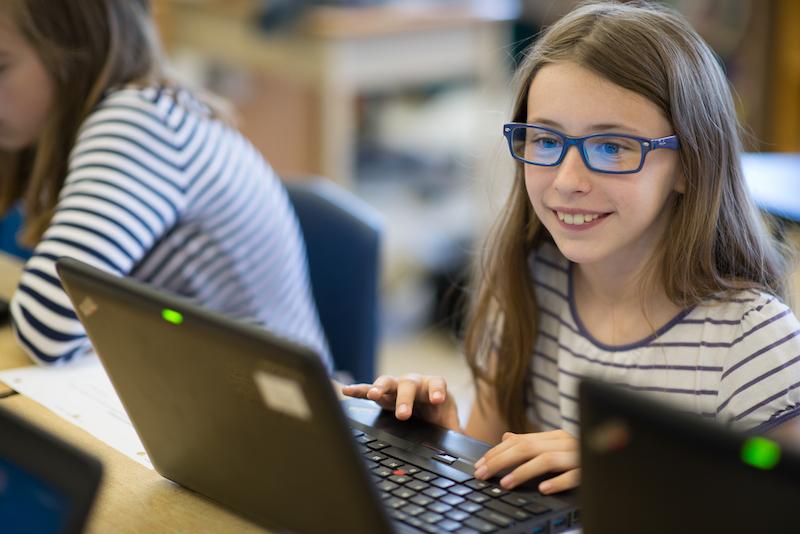
Adventures With Google Earth
“Seatbelts everyone!”
Who said it? Do you remember?
A young, curly-haired boy followed with, “Please let this be a normal field trip.” Then the rest of the class cheered and replied “With the Friz, no way!” Not long after, Little Richie piped in with the memorable and catchy theme song to The Magic School Bus. In every episode, those fictitious students climbed aboard a bus not knowing where they would end up or what they would learn. Ms. Frizzle gifted them with interactive and eye-widening learning experiences.
The last time I checked, the local dealership did not have magic school buses on their lot, but I do know that the iPads and Android phones that my students carry in their backpacks or the outdated computers in the lab that have access to dependable Internet grant a magic school bus-type experience for learning. Exit magic school bus, enter Google Earth. Instead of hopping aboard a bus to explore an Aztec Temple, zoom to the moon or swim through the ocean, my students in room 213 at Southwood Park Public School in Ajax can sit at their desks and explore an Aztec Temple using Street View, pan across the moon with their mouse cursor and literally dive 11,000 metres down into the Pacific Rim. Want to know what the coolest part of these activities is? The Ontario Social Studies/History/Geography curriculum offers potential connections to Google Earth on nearly every page of the 212-page document. The four corners of the globe instantly become accessible.
Seeing The Bigger Picture
I didn’t fall in love with history until my first year at university where I took my first history course about Western civilization. It was then I became captivated by the stories. In university, I learned to see the discipline of history as holistic and organic. Ontario teachers can teach that Cabot came to Canada first, then Cartier, and then Champlain and have students memorize the order and the dates so they’re ready for a test. But what if we saw the story-like bigger picture; Cabot was the first modern explorer (after the Vikings) to find untapped resources, and since he sailed for England, France and Spain were left behind in the 1500s’ equivalent of the space race. Instead of asking for the order of their journeys, ask students why they followed each other. A mindful big picture is more meaningful than dates alone.
So Why Inquiry?
One dictionary defines inquiry as “an act of seeking information by questioning, interrogating or investigating.” There’s something special about a question, isn’t there? Whether it comes from a textbook or a student, questions enrich learning. Here’s an example: Expectation A3.3 in Grade 5 asks students to examine the motives for European exploration. John Cabot, who is found in nearly every Canadian history textbook published since 1952, discovered the Grand Banks. He returned to King Henry VII announcing, “We must return because there’s enough fish to feed us till the end of time.” Ask yourself … how would you teach this?
A textbook would give a neat and tidy explanation of the facts and might even talk about why fish prefer shallower waters. You could add a paper map of Eastern Canada and have students colour in the Grand Banks to accompany the textbook facts. Or, you could frontload the important information in a mini-lesson and then let students explore the Grand Banks using Google Earth. Here are some sample inquiry ideas: Why are there two colours of blue? In a swimming pool, is the deep end darker or lighter? Why is the colour lighter around the land? Using Google Earth, have students zoom down close enough to populate the yellow Street View icon found on the right side and drop it over the water so they can actually dive into the sea. In the bottom right corner, there’s a depth marker in feet or metres (it can be changed in the preference tab). Now, have students choose three random spots around Newfoundland’s shore and measure the depth of the Grand Banks. They can then compare their measurements with their friends’.
Syracuse University’s Whitman School of Management’s rendition of Bloom’s Taxonomy states that the simplest form of learning, which teacher’s college taught us is knowledge, has students “recall, list and name information.” When given a worksheet, students can recall the lesson, list, label and name facts, and move on to something else. In this model, synthesizing is described as “using old ideas to create new ideas, imagine, infer and predict.” Offering students Google Earth allows them to explore and create. Further, inferring and predicting can come when students see that if the three light blue areas are the same colour, then the depth in each location is probably the same. You can tell students the Grand Banks are shallow or they can explore it themselves. Students can literally dive into their learning!
A Few Lesson Ideas Grade 4 Geography – Political and Physical Regions of Canada – B3.1 to B3.7
For the Grade 4 teachers out there, answer honestly if you’ve done the brochure assignment for the provinces and/or the geographical landforms of Canada unit. When I was in Grade 4, I did this assignment! Twenty years later, this assignment still surfaces in Grade 4 classrooms around Ontario. To spice it up, what if we offered our students the chance to explore their province of choice with Google Earth? Rather than a week of cutting and pasting paper, they could spend a week cutting and pasting pictures found in Google Earth using the snipping tool right in the Windows accessory tab to make a virtual brochure in Publisher. Or they could make an interactive slideshow in Powerpoint or Google Slides. You can use the exact same success criteria or checklist that includes a capital city, two attractions, a second major city, one natural landform and two examples of major natural resources. One extension that I heard a teacher add in one of my workshops was to have students use the video feature embedded right inside Google Earth to make a virtual tour of their province. It’s as easy as clicking start, moving around and then clicking stop. Every place your cursor visits when the recording is active gets recorded. Further still, your students have the option to use a narration tool when a video is being recorded if your library has access to a $5 microphone or $10 headset. It’s very engaging and, as they go, they’re asking and hopefully finding answers to their own and friends’ questions.
Grade 6 Geography – Canada’s Interactions with the Global Community – B3.7 and B3.8
The idea for this lesson came from one of my own inquiry questions – what is the trip that an iPod takes from China to Toronto? We started with finding out where Apple products are made at apple.co/1Ae9gpS. We chose a factory in northern China, one of the 300 located in the country, and put the address in Google Earth. From the manufacturing plant, we moved south to visit one of the dozen shipping ports in Hong Kong’s major harbour. In the harbour, using Street View, students saw thousands of containers and connected them to the containers they see on trains that follow alongside the 401. We took a fictitious boat ride across the Pacific and learned it takes 18 days to arrive at Port Metro Vancouver, Canada’s largest shipping port. Students compared the similarities and differences between the two ports using Street View. We learned through CNR and VIA Rail’s websites that it takes 3.5 days to travel from Vancouver to Toronto by train, making stops in major Canadian cities along the way. Once students practised navigating the sliding and dragging to show the journey, they could record the journey with Google Earth’s recording software.
You could easily turn the question back to the students to choose an item they love and to find out what journey it takes to get to your hometown.
Grade 7 – History – New France And British North America, 1713-1800
The earlier lesson ideas were from geography strands in the curriculum. This one comes from a history strand. In Grade 7, students learn about the conflicts and shifts of power between the French and the British that played out in Canada. One point of focus in the curriculum is the seizing of control of the many forts, especially during the Seven Years’ War. Location is a key term to remember. A virtual trip to the Fortress of Louisbourg is a place to start, allowing students to explore why this would be an important place to build a fort for defence reasons in times of war. Ask students to do some research on the history and importance of this fort before or during this lesson. They’ll discover that the French started with the fort in 1740, but the British really wanted it because of its location, and ended up winning it in 1745. It became a major bargaining chip in 1748 and was given back to the French in exchange for land in Belgium. The British never forgot about it, however, and won it back in 1758. Using Google Earth, students will be able to see that this fort gave its owner control of nearly every ship wanting to enter the St. Lawrence from the Atlantic.
After a day or two talking about Louisbourg, students may wish to move down the St. Lawrence and begin investigating the other forts that were fought over in the Seven Years’ War. Check out the battle for Fort Niagara. Positioned strategically at the mouth of the Niagara River, it was the only way to travel from Lake Ontario to Lake Erie and on through the entire Great Lakes system by water. The owner of Fort Niagara controlled access to four of the five Great Lakes! Other important forts to investigate from the Seven Years’ War include Fort Duquesne, Fort Frontenac, Fort Carillon and Fort William Henry. Students could later pan over Eastern Canada and choose a spot where they would build a fort and justify why.
Getting Hooked With Google Earth
So what motivates me to take students on virtual trips to the Coliseum or a coffee plantation in Costa Rica? When I was a student in elementary and high school, I was disengaged and uninterested in learning. Now that I am a teacher, I ask myself, “If I were in Grade 5, would I want to be in my own class?” Would I be excited to be a student in room 213?” If Google Earth had existed 20 years ago, I would have been hooked if my teachers had let me explore the grounds of the Taj Mahal in Street View.
Ryan Tindale is a member of the Durham Occasional Teacher Local. For free resources, videos and other technology-related ideas, visit his website teachingsmarter.wix.com/home.
